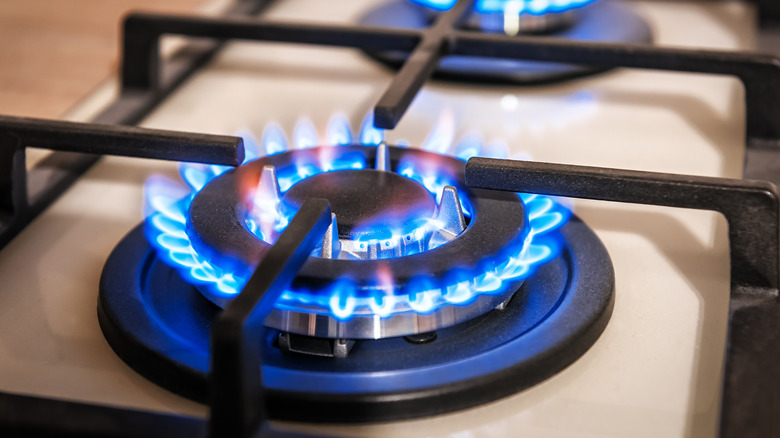The Best Way To Thoroughly Clean Your Gas Stovetop
Keeping your stovetop clean is an essential part of kitchen safety. Of course, spills happen sometimes. But leaving that spilled food stuck in your stovetop can create a breeding ground for plenty of bacteria — and it can generally look pretty gross. While some spills can be wiped up right away, it is important to deep clean and sanitize the whole stove every once in a while.
To thoroughly clean your gas stovetop, however, you'll need to pay attention to four different surfaces to sanitize. Flat, electric stovetops may only require a simple wipe with a cloth and some spray-on kitchen cleaner. On a gas stovetop, some parts can be removed and cleaned in the sink for a deeper cleanse, while other areas will need to be sanitized in place.
In order to protect the integrity of the stovetop and ensure your cooking surface stays bacteria free, you'll want to ensure you're cleaning each part of the gas stovetop correctly with a food-safe scrub. (And avoid any oven cleaning mistakes.)
Clean each section separately
The four main parts of the stove that need to be cleaned are the grates, burner caps, burner heads, and the stove surface. The grates are the topmost part of the stove, where pots and pans rest while cooking. Just underneath those are the disc-shaped burner caps that ensure an evenly spread heat while cooking.
Both components are removable and can be soaked in soapy water in the sink while you clean the rest of the stove. Or, if they have some stuck-on food, they can be cleaned a little more intensely with a baking soda-vinegar paste (or even toothpaste, so long as it has baking soda in it) and a sponge.
With the burner heads, you'll need to be aware of what's recommended for your specific model. When it comes to burner heads, designs can vary, and you'll want to choose a cleaning method that won't damage your appliance. Soft cloths or old toothbrushes are usually fairly harmless and won't damage surfaces. As far as cleaning materials go, vinegar is often fairly safe to use, too.
Put the stove back together to test it
The final step in the cleaning process is the stovetop itself. This can be wiped down with a damp washcloth, or you can use the cleaning paste. You can also take care of grease with a spray-on degreaser. Once it's been dried off, you can put back all the removable parts on the stove. After the stovetop has been reassembled, you should give each burner a test run to ensure that it's all functioning as it should.
In general, you should be deep cleaning your stovetop at least once a month, so long as there are no obvious lingering food messes left on it. A quick wipe down after every cooking session will generally keep things pretty clean (just make sure it's completely cool) and remove food particles that could cause bacteria buildup. But if your stovetop appears clean, a monthly deep clean can still prevent any risks of bacteria growth and ensure that your stove is safe to cook your meals on.


